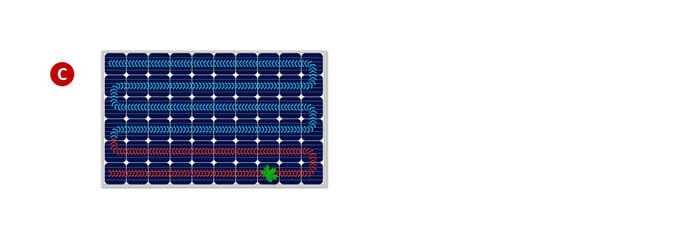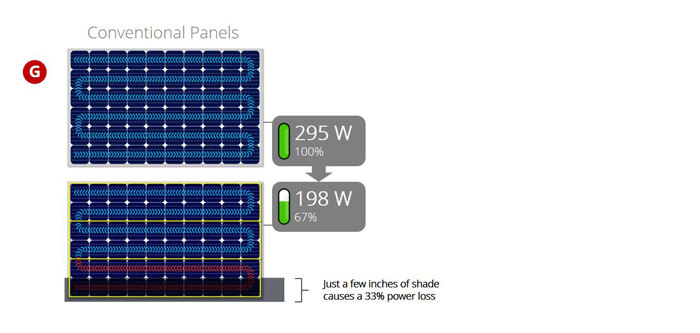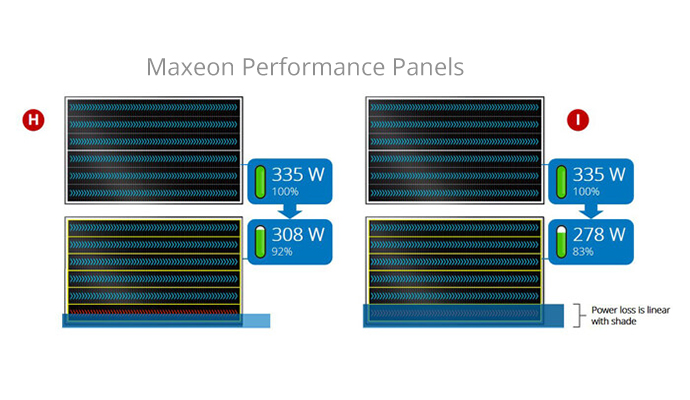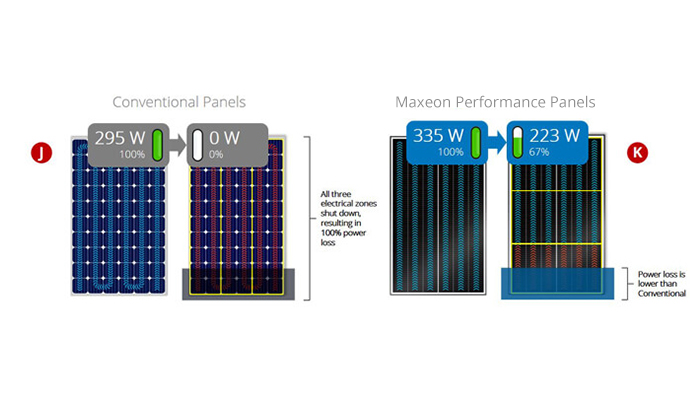Shade Happens

There’s an unfortunate reality many solar system owners only come to learn once they’ve installed solar: Shade happens. Not only is it inevitable, but it comes with a significant impact to the operation of your solar panels.
It might be from leaves falling off a nearby tree. It could be the result of “precision targeting” from a flock of birds passing overhead. Or, it could simply be a nearby structure that casts a hard shadow across your panels each morning.
However the shade gets there, the result is the same, as it restricts the flow of direct sunlight to your panels and limits the reliable operation of your system.
Now for the good news. Not all solar panels are created equal—and you can actually minimize the impacts of shading by choosing a better solar panel for your system. The design and engineering that go into your panels truly makes a difference in the amount of energy your system will produce.
Here are a few key scenarios to consider.
Maxeon Performance Panels vs. Conventional Panels
Scenario 1: Spot Shadows
We’ll start with a standard front-contact conventional solar panel. Notice how current flows through the panel in a continuous, serial circuit (A). Any interruption to this flow, can have detrimental effects on panel operation. Therefore, the panel is typically partitioned into three distinct electrical zones which allows the panel to bypass obstructions to energy flow should one occur (B).

Now, let’s consider the shade from a single leaf. It doesn’t look like much, but it can zap some serious power from your panel (C). When we place that leaf over a cell in the conventional panel, the cell can no longer generate power, nor can it properly pass power between adjacent cells. Unable to function properly, the obstructed cell forces an entire electrical zone of the panel to shut down until the leaf is removed. That means 33% of the panel shuts down, which translates to a 33% loss in power. All from one leaf!

Maxeon Performance panels on the other hand, are engineered to keep energy flowing in independent, parallel rows (D). Each row of cells employs flexible, redundant paths for energy to move from cell to cell, limiting the impact of obstructions on the panel surface. In addition, the electrical architecture of the panel is partitioned in a cross-section pattern (six horizontal rows and three vertical columns) that allows for enhanced performance in portrait or landscape orientation (E).

Below we see how the smaller cells and redundant electrical connections of the Performance panel work to mitigate the effects of that same leaf that landed on the conventional panel (F). Where the conventional technology shut down one third of the panel, the Maxeon Performance panel’s unique electrical architecture enables a continuous flow of energy with very minimal power loss.

Scenario 2: Linear Shading in Landscape Orientation
Now, let’s take a look at a more linear shadow cast on the surface of the conventional panel. Once again, we see an immediate impact on the conventional panel (G). As the shadow is cast on the long edge of the panel (landscape orientation), the conventional panel quickly shuts down one of its three electrical zones to bypass the shading. Just like the spot shadow from the leaf, we see a 33% drop in power. In this case, a 295 W panel, quickly becomes a 198W panel.

As the long edge of the Performance panel becomes shaded, power loss is in proportion to the shade. This means that if only half of the first row of cells is shaded for example (H), the other half of the cells in that row are still producing energy, and the panel is operating at 92% of its power rating. Should shade completely cover the bottom row of cells (I), the Performance panel will only experience a 17% drop in power (1/6 of the panel) as opposed to the 33% drop we see in the conventional panel above. You can see here how just a few inches of shade can make a considerable impact on panel power.

Scenario 3: Linear Shading in Portrait Orientation
It’s highly recommended that Performance panels be installed in landscape orientation to maximize energy output and savings. However, should the panel be placed in portrait orientation, it continues to have a significant advantage over the conventional panel. As shade appears on the bottom (short edge) of the conventional panel, it quickly affects all three electrical zones, completely shutting down the panel (J).

Going back to that cross-section of electric zones in the Performance panel, we see how the panel, when turned on its short edge, re-routes energy flow through the top 2/3 of the panel (K). It takes a hit, but we can likely agree that having 67% of your panel generating energy is better than nothing.
When you consider the impact of shade on a panel’s energy generation potential, the examples above demonstrate how the design and engineering that go into your panel, can lead to a more reliable source of energy over the lifetime of your system.
And while some panel manufacturers will not even warrant their panels against damage from shading, we back our panels with a robust 25 years warranty, even when shaded.
While these are just a few examples of shading your installation may experience, we encourage you to learn more about how the reliability and durability of Maxeon Performance panels can maximize the energy production of your installation.
AUTHOR’S NOTE: This blog is intended to address the varied impacts of shading on solar panels and demonstrate how superior design and engineering can minimize the impacts of shading. We highlight a few illustrative examples above and do not intend for this article to fully represent the almost infinite permutations from which shade can affect solar panels. We encourage you to engage in thoughtful dialogue with your Maxeon Solar Technologies sales representative to fully realize the benefit of Maxeon Performance technology. In addition, power ratings are used for illustrative purposes only, ratings may vary based on product availability in specific markets.